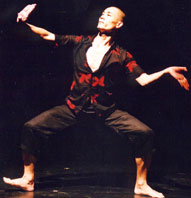

Iku Otani, Director, NPO DANCE BOX
Norikazu Otani, Director, NPO JCDN (Japan Contemporary Dance Network)
Interviewer: Akemi Tsukada, NLI Research Institute
Performing Arts has a history of residency-based production. Contemporary dancers, in particular, have embraced this style, co-producing perfromances with overseas companies and collaborating with artists from other genres.This is an interview with the members of the two leading dance NPOs, Mr. Iku Otani of DANCE BOX and Mr. Norikazu Sato of JCDN.
(* Refer to AIR-JAPAN Database for the details of this program)
Contemporary Art and Artist-in-Residence Programs
──First, could you tell us the objectives of your artist-in-residence programs and the role such programs play in the activities at DANCE BOX and JCDN?
Otani──Since 2003, DANCE BOX has worked as a partner for the ART-EX program (Artist-in-Residence Program). For the 2006 program, we hosted the choreographer, Jean Gaudin to take residency with us for approximately two months. Gaudin’s concept of dance is to do the unconventional, so he worked with images and also with a Kansai-based artist to make his new work, which incorporated images of Osaka.
In February 2007, we organized the Osaka Asia Contemporary Dance Festival 2007, and hosted one of the guest choreographer, Pichet Klunchun, from Thailand. His dance emphasizes the fundamental forms of traditional mask dance Khon, while deconstructing its structure at the same time. As such is his style, he has difficulties pursuing this in Thailand, so we suggested that he could work with us in Osaka. We held a workshop-based audition and took three weeks to create a new work. The work was completed as an outcome of this residency. It is now scheduled to be staged in Bangkok and Okinawa in December. The performance in Okinawa will be part of the opening program for a new theater.

Pichet Klunchun, from Thailand
──So, your residence program is about producing experimental works and collaborating with different genres?
Otani──Yes. A theater needs to have a function that promotes production of new works. I am also constantly thinking about touring these new works to other theaters.Residence programs are interesting because they could be linked to such ideas.
──Mr. Sato, how about your activities at JCDN?
Sato──In 1996, I lived in New York for a year. I realized that many Japanese artists visit New York to take part in performances, but when the occasion is just to work for the staged programs, they only stay in the theater and the hotel.I thought this was a waste of opportunity. Such thoughts were on my mind when I participated in the “Triangle Program,” a tri-national project involving Indonesia, the United States, and Japan. The participants stayed in each of these countries for one month, and traveled for a total of three months together. Its objective was to stage a dance performance and workshop, but we, as participants, had a lot of time to discuss things with each other, and also had an opportunity to experience the local ways of living. This, in the end, exerted a great influence on each participant.
Using residency for the purpose of creating a new work is common in the performing arts, but there should be programs that emphasize the residency process. Residency in itself is meaningful.
──What is the length or duration of the program you envision when you mention “residency program”?
Otani──Artists could get used to the local conditions in about a week, but if they were to provide their ideas and coordinate with each other to produce new ideas and present new ways of thinking, they would need at least a month or two, before they could complete a production of a new work.
The Impact on the Local Community
Sato──When artists stay in one community for a month, they will always eat at local eateries, talk with the locals during their shopping, and so on. Through such interactions, they build a relationship with the hosting community, and that community becomes the artists’ second home. I want to create as many second homes of the artists as possible through our residency program.
When I go to the regional cities as part of my work at JCDN, local coordinators often ask me, “How can we contribute?” I always tell them that they need to nurture local talents. To realize this, they need to have artists live in their cities, immerse them in the locality, and turn them into a local artist.
Artists are professional when it comes to creating new values and introducing new perceptions. They are also professional in communication, too. This is why, when the local community is trying out something new, artists have the power to help them move forward and encourage them to pursue their goals. The artist-in-residence program is an important first step into creating an environment in which the artists are acknowledged as regular members of the community that could contribute in such a way.
The Selection Process
──By the way, what is the selection process for the performing art residency programs?
Sato──It is not usual to invite an artist who I do not know well. I invite artists who I have worked with for at least once in the past, for example, in a performance; someone I could trust to do something interesting.
Otani──If the artists approach us with proposals, I first ask them to show me their works. The program could fail if we are not careful in judging whether or not the artist could offer new potentials.
Sato──When working with local communities, failing once could mean no more chances. Naturally, we are very careful. If the artist leaves an impression on the community that dancers are a terrible bunch, then the seed of art will not have a chance to grow. There are not many Japanese artists who are conscientious about their roles and missions in the society yet.
The Grant System; How Do We Support the Artist-in-Residence Program?
Sato──Many grants that are available in Japan are aimed at supporting productions of specific works and performances. Grants dedicated to supporting residency programs are not available. So, if any of the institutions start supporting residencies, that could create a surge in interest. The money could be small. 300,000 yen to do a performance is not so big a sum, but for a residency program, the same amount could over a month worth of hotel accommodation.
Another way would be to collaborate with public theaters and halls that are interested in community-based programs. They could provide the residency facilities and co-produce a work that could eventually tour to other theaters and halls.
──That is a good idea. It would be useful to think of ways to support performing arts residencies.
The Future of Artist-in-Residence Programs
──Finally, could you tell us about what your future visions are for the residency programs?
Otani──Residency programs offer a great opportunity to discover new ways of expression in the process of producing new works. The same could be said for collaborations with artists of different nationalities, and different communities. These opportunities enable the artist to create a work that would have never been born if he/she were working on his/her own.
If we were to talk about “social inclusion,” residency programs could be a lubricant for deepening the artists’ relationship with the local community. They could deliver art to those who normally do not access art. It enables artists to communicate with people who thought they were not related to art at all.
Sato──I may be repeating myself, but residencies can create second homes for artists. For the community, this means that they have local artists living all over the world. An artist-in-residence program can provide the initial step in creating such relationships.
──Thank you.
[May 26, 2007 at Festival Gate Art Theater dB]
2024.7.9Acasă la Hundorf Residency JournalArtist : Miyake Suzuko
2023.5.14AIR and I, 09 : Mentoring Artists for Women’s Art (MAWA) Residence Report